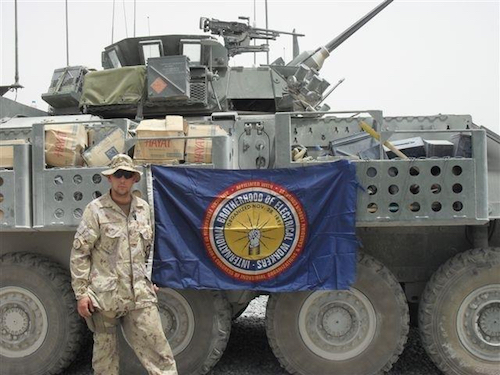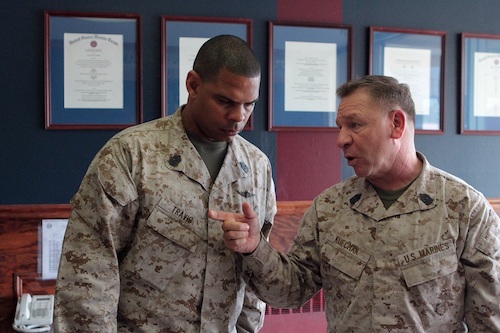This Nov. 11 we pay tribute to our brave servicemen and women in the U.S. and Canada. But honoring our veterans includes making sure they return home with the career opportunities they deserve, and for many, that means a career in the trades.

|
| The IBEW salutes the servicemembers of the U.S. and Canada, like Windsor, Ontario, Local 773 member Roger Miner, pictured, who served with the Canadian Armed Forces in Afghanistan.
|
The IBEW is proud to count tens of thousands of veterans among our ranks. Their military training and discipline make them ideal candidates for our apprenticeships and other training programs.
“Our military brothers and sisters come in to the IBEW not just with the requisite skills and discipline, but with a real sense of the significance of a brotherhood, of what solidarity means,” said International President Lonnie R. Stephenson.
Approximately 250,000 people leave military service in the U.S. each year, according to the Defense Department. Through programs like Helmets to Hardhats and Veterans in Energy, the building trades are reaching out to servicemembers who are transitioning out of the military and looking for a new opportunity – one that will provide them with a fair wage and benefits to support their families.
The Veterans Electrical Entry Program is another way the IBEW is helping servicemembers transition into a rewarding electrical career. The program, run by the IBEW and NECA’s Electrical Training Alliance works with base leadership to provide an opportunity for servicemen and women in their final six months to complete their first year of apprenticeship training in an intensive, full-time course.
Anchorage, Alaska, Local 1547 was one of the first to adopt the curriculum, working with leaders at nearby Joint Base Elmendorf-Richardson.
“You can drive a tractor trailer in the military for 20 years and still not qualify for your commercial driver’s license,” said Kyle Kaiser, lead organizer for Local 1547. “VEEP helps in this regard because it is open to any veteran, regardless of the duty assignment or occupational specialty they had in the military. So, it’s easier for an infantryman to become a wireman.”

|
| Retired Sgt. Maj. Mike Kufchak left the 1st Marine Infantry Division after 31 years to become director of veterans' affairs for Los Angeles Local 11. Read his story here. Photo credit: United States Marine Corps
|
Graduates of the program then choose a local near where they’ll live after leaving the military and the VEEP program works to place them as a second-year apprentice.
Last year, the IBEW also began the process of creating an international Veterans Committee with representatives from each of the 11 districts, joining committees already in place at the local level and encouraging more locals to charter committees to support their own veterans.
“Whether it's organizing the local Veterans Day parade, sending care packages to troops overseas or staffing a job fair booth at a nearby base, I expect these committees will lead the way for their communities' veterans in the years to come,” Stephenson said in his column for the November edition of the Electrical Worker.
The Third District, which includes locals in Delaware, New Jersey, New York and Pennsylvania, recently held its first Veterans Committee meeting at Scranton, Pa., Local 81, with almost 40 locals in attendance.
“We owe our veterans more than we can fully express in just one day,” Stephenson said. “It’s because of their sacrifices that we can enjoy all we do in our countries. And it’s because of that service that I want to extend a hand to anyone in the military who is considering a career in the trades, one where they can have a sense of accomplishment, another ‘band of brothers’ and job security and an assured retirement. We’re here for you.”